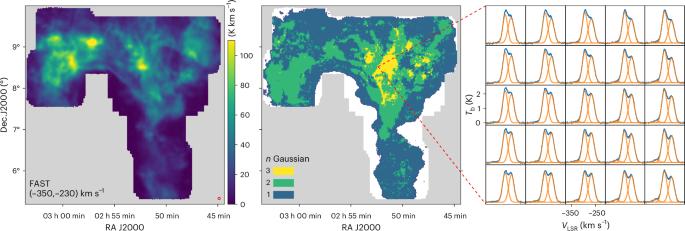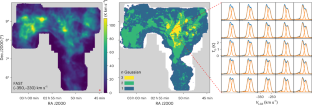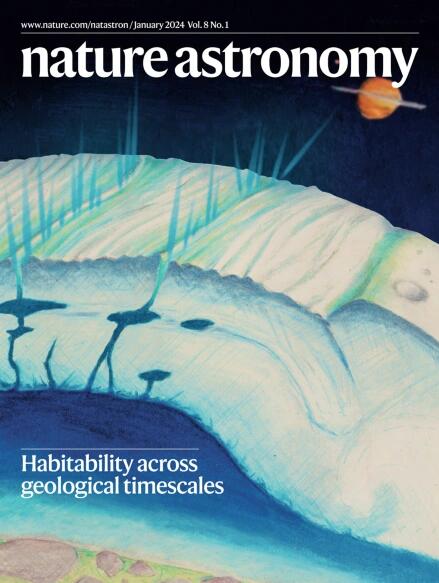A network of velocity-coherent filaments formed by supersonic turbulence in a very-high-velocity H i cloud
IF 14.3
1区 物理与天体物理
Q1 ASTRONOMY & ASTROPHYSICS
引用次数: 0
Abstract
The warm neutral medium (WNM) was thought to be subsonically/transonically turbulent, and it lacks a network of intertwined filaments that are commonly seen in both molecular clouds and the cold neutral medium. We report H i 21-cm-line observations of a very-high-velocity (−330 km s−1 < VLSR < −250 km s−1) cloud (VHVC), using the Five-Hundred-Meter Aperture Spherical Radio Telescope (FAST), with very high resolution and sensitivity. Such a VHVC is here clearly revealed to be a supersonic WNM system consisting of a network of velocity-coherent H i filaments. The filaments are in the forms of slim curves, hubs and webs, distributed in different layers within the position–position–velocity (ppv) data cube. The entire cloud has skewed lognormal probability distribution of column density and the filaments themselves show asymmetrical radial density profiles, indicating shock compression by supersonic magnetohydrodynamic (MHD) turbulence, as is also confirmed by our MHD simulation (sonic Mach number Ms = 3 and Alfvén Mach number MA = 1). This suggests that hierarchical filaments can be established by shocks in a low-density WNM, where gravity is negligible, offering a viable pathway to structure formation in the earliest evolutionary phases of the interstellar medium. High-resolution FAST observations of a very-high-velocity cloud in the warm neutral medium reveal a network of hierarchical filaments formed by shock compression. These findings suggest a viable mechanism for early structure formation in the interstellar medium.


超高速H云中由超音速湍流形成的速度相干细丝网
热中性介质(WNM)被认为是亚音速/跨音速湍流,它缺乏分子云和冷中性介质中常见的缠绕细丝网络。我们报告了利用500米口径球面射电望远镜(FAST)对超高速(- 330 km s - 1 < VLSR < - 250 km s - 1)云(VHVC)的H - 21厘米线观测,具有非常高的分辨率和灵敏度。这种VHVC在这里清楚地揭示了一个由速度相干H - i细丝网络组成的超音速WNM系统。这些细丝以细长曲线、轮毂和网状的形式分布在位置-位置-速度(ppv)数据立方体内的不同层中。整个云团柱密度呈对数正态分布偏斜,细丝本身呈不对称的径向密度分布,表明超音速磁流体动力学(MHD)湍流对激波的压缩,这一点也得到了我们的MHD模拟(音速马赫数Ms = 3和alfv马赫数MA = 1)的证实。这表明,在重力可以忽略不计的低密度WNM中,激波可以建立分层细丝,这为星际介质最早进化阶段的结构形成提供了一条可行的途径。
本文章由计算机程序翻译,如有差异,请以英文原文为准。
求助全文
约1分钟内获得全文
求助全文
来源期刊

Nature Astronomy
Physics and Astronomy-Astronomy and Astrophysics
CiteScore
19.50
自引率
2.80%
发文量
252
期刊介绍:
Nature Astronomy, the oldest science, has played a significant role in the history of Nature. Throughout the years, pioneering discoveries such as the first quasar, exoplanet, and understanding of spiral nebulae have been reported in the journal. With the introduction of Nature Astronomy, the field now receives expanded coverage, welcoming research in astronomy, astrophysics, and planetary science. The primary objective is to encourage closer collaboration among researchers in these related areas.
Similar to other journals under the Nature brand, Nature Astronomy boasts a devoted team of professional editors, ensuring fairness and rigorous peer-review processes. The journal maintains high standards in copy-editing and production, ensuring timely publication and editorial independence.
In addition to original research, Nature Astronomy publishes a wide range of content, including Comments, Reviews, News and Views, Features, and Correspondence. This diverse collection covers various disciplines within astronomy and includes contributions from a diverse range of voices.
 求助内容:
求助内容: 应助结果提醒方式:
应助结果提醒方式:


